After an unusually warm and rainy November, winter has finally descended on our little town. We woke up this morning to chilly sub-zero temperatures and a blanket of snow. So I thought this would make for an appropriate December tune of the month. “To Drive the Cold Winter Away” (also known as “All Hail to the Days”) is one of my favourite seasonal tunes, a standard with my early music ensemble and my flute, harp and cello trio. Because the words are also quite lovely, I’ve also included the lyrics to the song below. The duet part was written for our cello player. If you want to use the bass as a left hand part for solo harp, you can leave out the G# if you don’t have G levers, or don’t feel like flipping in the middle of the piece.

The HarpBlog Tune of the Month is courtesy of Chubby Sparrow Music . For a printable version, right click on the picture and choose “save target as”, or pop over to the Chubby Sparrow Free Music page for more detailed printing instructions (note: if you just left click and try to print directly from the browser, it probably won’t print at the right size).
Lyrics: “All Hayle to the Dayes”, Eng. trad.
All hayle to the days that merit more praise
Than all the rest of the year!
And welcome the nights that double delights
As well for the poor as the peer!
Good fortune attend each merry man’s friend
That doth but the best that he may,
Forgetting old wrongs with carols and songs
To drive the cold winter away.
To mask and to mum, kind neighbours will come
With wassails of nut-brown ale,
To drink and carouse with all in the house
As merry as bucks in the dale;
Where cake, bread and cheese are bought for your fees
To make you the longer stay;
The fire to warm, will do you no harm,
To drive the cold winter away.
Thus none will allow of solitude now
But merrily greet the time,
To make it appear of all the whole year
That this is accounted the prime:
December is seen apparel’d in green,
And January fresh as May
Comes dancing along with a cup and a song
To drive the cold winter away.
This time of the year is spent in good cheer,
Kind neighbours together do meet
To sit by the fire with friendly desire
Each other in love to greet;
Old grudges, forgot, are put in the pot,
All sorrows aside they lay;
The old and the young doth carol this song
To drive the cold winter away.








